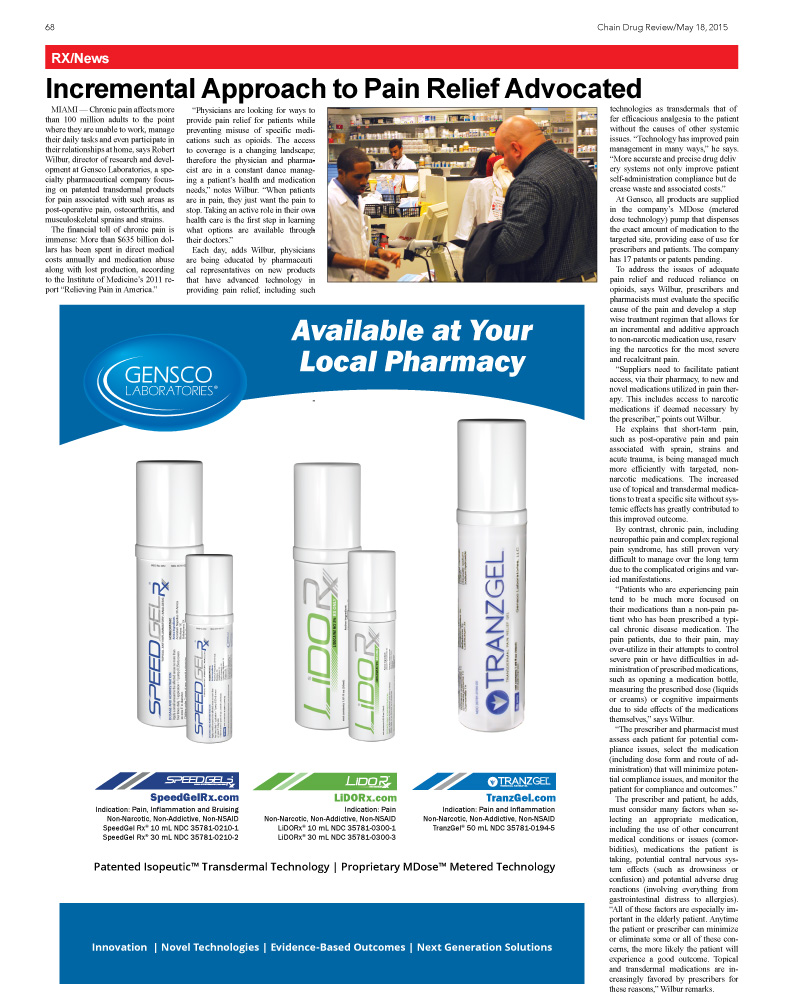May 18th, 2015 – As Seen In Chain Drug Review, Rx News:
Chronic pain affects more than 100 million adults to the point where they are unable to work, manage their daily tasks and even participate in their relationships at home, says Robert Wilbur, director of research and development at Gensco Pharma, a specialty pharmaceutical company focusing on patented transdermal products for pain associated with such areas as post-operative pain, osteoarthritis, and musculoskeletal sprains and strains.
The financial toll of chronic pain is immense: More than $635 billion dollars has been spent in direct medical costs annually and medication abuse along with lost production, according to the Institute of Medicine’s 2011 report “Relieving Pain in America.”
“Physicians are looking for ways to provide pain relief for patients while preventing misuse of specific medications such as opioids. The access to coverage is a changing landscape; therefore the physician and pharmacist are in a constant dance managing a patient’s health and medication needs,” notes Wilbur. “When patients are in pain, they just want the pain to stop. Taking an active role in their own health care is the first step in learning what options are available through their doctors.”
Each day, adds Wilbur, physicians are being educated by pharmaceutical representatives on new products that have advanced technology in providing pain relief, including such technologies as transdermals that offer efficacious analgesia to the patient without the causes of other systemic issues. “Technology has improved pain management in many ways,” he says. “More accurate and precise drug delivery systems not only improve patient self-administration compliance but decrease waste and associated costs.”
At Gensco, all products are supplied in the company’s MDose (metered dose technology) pump that dispenses the exact amount of medication to the targeted site, providing ease of use for prescribers and patients. The company has 17 patents or patents pending.
To address the issues of adequate pain relief and reduced reliance on opioids, says Wilbur, prescribers and pharmacists must evaluate the specific cause of the pain and develop a step-wise treatment regimen that allows for an incremental and additive approach to non-narcotic medication use, reserving the narcotics for the most severe and recalcitrant pain.
“Suppliers need to facilitate patient access, via their pharmacy, to new and novel medications utilized in pain therapy. This includes access to narcotic medications if deemed necessary by the prescriber,” points out Wilbur.
He explains that short-term pain, such as post-operative pain and pain associated with sprain, strains and acute trauma, is being managed much more efficiently with targeted, non-narcotic medications. The increased use of topical and transdermal medications to treat a specific site without systemic effects has greatly contributed to this improved outcome.
By contrast, chronic pain, including neuropathic pain and complex regional pain syndrome, has still proven very difficult to manage over the long term due to the complicated origins and varied manifestations.
“Patients who are experiencing pain tend to be much more focused on their medications than a non-pain patient who has been prescribed a typical chronic disease medication. The pain patients, due to their pain, may over-utilize in their attempts to control severe pain or have difficulties in administration of prescribed medications, such as opening a medication bottle, measuring the prescribed dose (liquids or creams) or cognitive impairments due to side effects of the medications themselves,” says Wilbur.
“The prescriber and pharmacist must assess each patient for potential compliance issues, select the medication (including dose form and route of administration) that will minimize potential compliance issues, and monitor the patient for compliance and outcomes.” The prescriber and patient, he adds, must consider many factors when selecting an appropriate medication, including the use of other concurrent medical conditions or issues (comorbidities), medications the patient is taking, potential central nervous system effects (such as drowsiness or confusion) and potential adverse drug reactions (involving everything from gastrointestinal distress to allergies). “All of these factors are especially important in the elderly patient. Anytime the patient or prescriber can minimize or eliminate some or all of these concerns, the more likely the patient will experience a good outcome. Topical and transdermal medications are increasingly favored by prescribers for these reasons,” Wilbur remarks.
